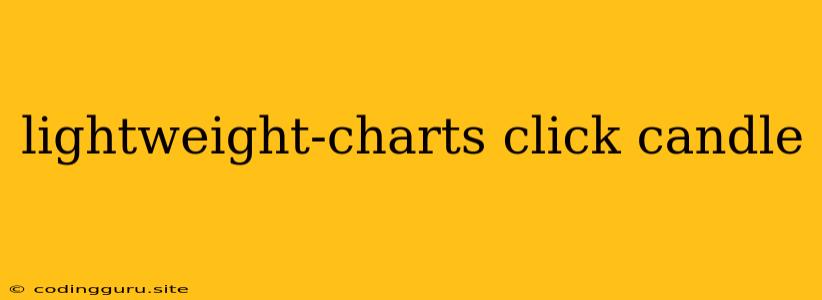Lightweight Charts: A Comprehensive Guide
Lightweight Charts is a free and open-source JavaScript charting library designed for building interactive financial charts. Its primary focus is to deliver a lightweight and performant solution, making it ideal for applications demanding smooth chart rendering even with large datasets.
One of the core functionalities of Lightweight Charts is the ability to interact with candlestick elements, commonly used to visualize price movements in financial markets. In this guide, we'll explore how to implement click events for candles in Lightweight Charts, enabling users to access detailed information and perform actions based on their selections.
Understanding Candle Click Events
Before diving into the implementation, let's understand the concept of click events in the context of candles within Lightweight Charts. When a user clicks on a specific candlestick, the library triggers an event that you can capture and utilize to execute custom logic. This allows you to build interactive features such as:
- Displaying Tooltips: Show detailed information about the selected candlestick, including its open, high, low, and close values.
- Highlighting Candles: Visually emphasize the selected candlestick to enhance user focus.
- Triggering Actions: Initiate specific actions based on the chosen candlestick, like navigating to a related page or displaying additional charts.
Implementing Candle Click Events
The following steps guide you through implementing click events for candles using the Lightweight Charts library:
1. Initialization and Configuration
Start by initializing the Lightweight Charts library and creating a chart object. Set up the necessary configurations, including the chart type, series, and other visual elements.
const chart = LightweightCharts.createChart(document.getElementById('chart'), {
width: 800,
height: 600,
layout: {
backgroundColor: '#fff',
textColor: '#000',
},
grid: {
vertLines: {
visible: true,
},
horzLines: {
visible: true,
},
},
});
const candleSeries = chart.addCandlestickSeries({
upColor: '#4bff81',
downColor: '#ff4545',
borderDownColor: '#ff4545',
borderUpColor: '#4bff81',
});
// Load your data into the candlestick series.
2. Registering the Click Event Listener
Once the chart is initialized, register a click event listener using the chart.subscribeCrosshairMove method. This method allows you to capture mouse interactions within the chart, including clicks.
chart.subscribeCrosshairMove((param) => {
if (param.time) {
const clickedCandle = candleSeries.getCandleValue(param.time);
if (clickedCandle) {
// Access the properties of the clicked candle.
const open = clickedCandle.open;
const high = clickedCandle.high;
const low = clickedCandle.low;
const close = clickedCandle.close;
// Perform actions based on the clicked candle.
console.log('Clicked candle data:', open, high, low, close);
}
}
});
3. Accessing Candle Data
Within the event listener function, you can access the data associated with the clicked candle using the getCandleValue method of the candlestick series. This method takes the timestamp of the clicked candle as input and returns an object containing the candle's properties:
open: The opening price of the candle.high: The highest price of the candle.low: The lowest price of the candle.close: The closing price of the candle.
4. Implementing Actions
Based on the retrieved candle data, you can implement any desired actions, such as:
- Displaying a Tooltip: Create a tooltip element and position it near the clicked candle to display its open, high, low, and close values.
- Highlighting the Candle: Change the color or border of the selected candle to visually emphasize it.
- Triggering Navigation: Redirect the user to a specific page or section based on the selected candle.
Example
Let's demonstrate how to display a tooltip when a user clicks on a candle:
chart.subscribeCrosshairMove((param) => {
if (param.time) {
const clickedCandle = candleSeries.getCandleValue(param.time);
if (clickedCandle) {
const tooltip = document.getElementById('tooltip');
tooltip.style.left = param.point.x + 'px';
tooltip.style.top = param.point.y + 'px';
tooltip.innerHTML = `
Open: ${clickedCandle.open}
High: ${clickedCandle.high}
Low: ${clickedCandle.low}
Close: ${clickedCandle.close}
`;
tooltip.style.display = 'block';
} else {
const tooltip = document.getElementById('tooltip');
tooltip.style.display = 'none';
}
}
});
This code snippet creates a tooltip element (<div id="tooltip"></div>) in your HTML. When a user clicks on a candle, the code positions the tooltip near the clicked point and populates it with the candle's data. When the mouse moves away from the candle, the tooltip is hidden.
Conclusion
By implementing click events for candles in Lightweight Charts, you can empower users to interact directly with your financial charts, unlocking a range of possibilities for data exploration and action triggering. This guide has shown you how to capture candle clicks, access the associated data, and perform custom actions based on user selections. Utilize this functionality to enhance your financial applications and provide your users with a richer, more engaging experience.
